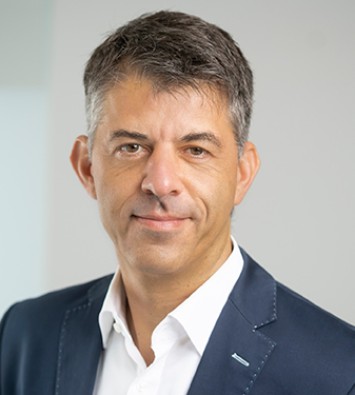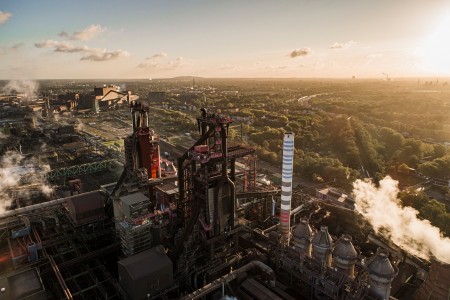Daily press, 2022-02-15, 08:00 am
Climate-neutral future of steel production: Real-world laboratory of the energy transition H2Stahl project to start at Duisburg site of thyssenkrupp Steel
- Use of hydrogen in blast furnace to be expanded.
- Large-scale industrial hydrogen supply via new pipeline.
- Construction and operation of a hydrogen-based direct reduction pilot plant.
- Total funding by BMWK in the amount of 37 million euros.
Duisburg, February 15. The real-world laboratory of the energy transition that has been granted funding in the amount of 37 million euros by the Federal Ministry for Economic Affairs and Climate Action will be implemented. By launching the H2Stahl project in Duisburg, the consortium members thyssenkrupp Steel, Air Liquide Deutschland and VDEh Betriebsforschungsinstitut (BFI, project coordination) have now set the course for the first steps. The tasks at hand are the expansion of the use of hydrogen to the entire blast furnace 9, including the construction of a pipeline for testing the large-scale industrial use of hydrogen in steelmaking, as well as the construction and trial operation of a direct reduction pilot plant which will mark the technological leap to hydrogen-based climate-neutral hot metal production. The entire cost of the project to be implemented within a five-year period amounts to a high double-digit million figure.
Industrialization of the use of hydrogen in the blast furnace
On November 11, 2019, thyssenkrupp Steel was the first company globally to inject hydrogen into a blast furnace during operation. Hydrogen replaces pulverized coal as additional reducing agent. The goal is to reduce CO2 emissions – for unlike carbon, hydrogen does not react in the blast furnace to form CO2, but water. The first series of tests funded by the Ministry of Economic Affairs of North Rhine-Westphalia performed on one tuyere of blast furnace 9 in Duisburg was successfully completed. The focus of the project was in particular to gain knowledge about the plant technology when using hydrogen.
Within the scope of the real-world laboratory H2Stahl funded by the Federal Ministry for Economic Affairs and Climate Action, the use of hydrogen will now be expanded to all 28 tuyeres of the blast furnace. The objective of the research is – amongst others – investigating the influence of the industrial use of hydrogen on the metallurgical processes in the blast furnace and determining parameters for the efficient use of reducing agents. The overall aim is to establish the use of hydrogen as bridging technology for the technical CO2 reduction in existing blast furnaces. Provided that sufficient quantities of green hydrogen are available, CO2 emissions can be reduced by up to 20 percent on one plant. The funding is based on the conviction that on the road to the transformation of the energy system the large-scale industrial use of hydrogen will help make the German steel industry not only climate-friendly, but also competitive in the future.
Link to hydrogen infrastructure through new pipeline
Along with the expansion of the use of hydrogen to all 28 tuyeres of blast furnace 9, the internal infrastructure of the plant will be prepared for the large-scale industrial supply with hydrogen. This includes also the link to the existing hydrogen infrastructure of Air Liquide. To secure the continuous hydrogen supply of the blast furnace, the project partner Air Liquide will build an about six kilometers long pipeline linking the steel plant in Duisburg with Air Liquide’s production network. Gilles Le Van, Vice-President Large Industries and Energy Transition Air Liquide Central Europe: “By using hydrogen at Europe's largest steel site in Duisburg, thyssenkrupp and Air Liquide are advancing the decarbonization of steel production. It is a great pleasure for Air Liquide to contribute its know-how thus helping to reconcile effective climate protection and international competitiveness in steel production”.
Direct reduction pilot plant to prepare the technology changeover
As part of the H2Stahl project, a direct reduction pilot plant will also be built in order to prepare the technology changeover from the conventional blast furnace route to the hydrogen-based direct reduction process. The use of hydrogen-containing process gases in combination with natural gas and pure hydrogen is to be tested in the new plant to be designed, which will be operated and scientifically supervised by BFI. Aside from the commonly used feedstock for direct reduction plants, other materials containing iron oxide, including potentially suitable waste materials, will be used. The direct reduction pilot plant will be equipped with additional measurement equipment enabling scientific evaluation. The tests in the direct reduction pilot plant will be accompanied by modeling and special studies in the Technical Center of BFI. The planned research work will focus on the investigation into the reduction processes and process parameters in order to ensure the smooth transition to the future large-scale plants.
“The flexible use of hydrogenous gases as well as various feedstock containing iron oxide in a direct reduction process is quite a challenge. The scientific investigations will provide essential information on the safe and efficient operation of the processes as well as the appropriate operating parameters“, says Michael Hensmann, Head of Resource Technology Feedstock department of BFI, and adds: “The facilities created in the H2Stahl real-world laboratory will enable urgently required investigations with a view to the climate-friendly transformation of the steel industry“. thyssenkrupp plans to complete the first industrial direct reduction plant including melting unit by 2025.
Consistent implementation of the transformation strategy
The launch of the H2Stahl project marks the next important milestone on the way towards climate-neutral steel production. “We are now starting to prepare our plant infrastructure for the large-scale industrial use of hydrogen“, explains Dr. Arnd Köfler, thyssenkrupp Steel’s CTO. “With the pipeline link to the existing hydrogen infrastructure of Air Liquide, we are giving another impetus for ramping up the production of green hydrogen as quickly as possible, because there is a demand for it“. H2Stahl does not only permit to gain important information on the changeover to direct reduction: The use of hydrogen in the blast furnace permits to significantly reduce CO2 emissions – depending on the availability of green hydrogen. “With H2Stahl we combine two phases of our climate strategy: on the one hand the industrialization of hydrogen use in existing blast furnace-based technology routes already involving significant CO2 reductions in the production process, and on the other hand the preparation of the direct reduction process by building up the infrastructure and thoroughly preparing the technological process”, adds Köfler.





